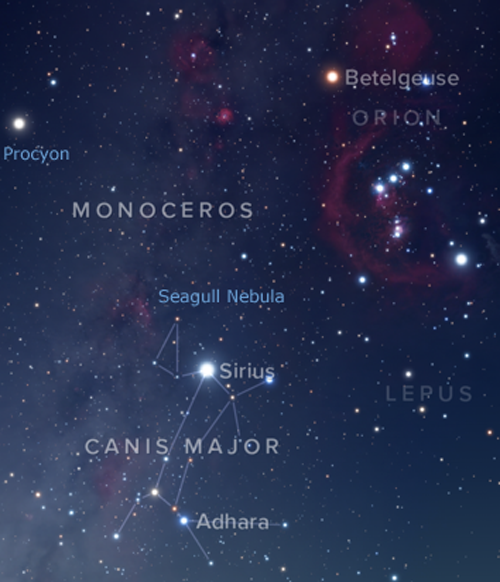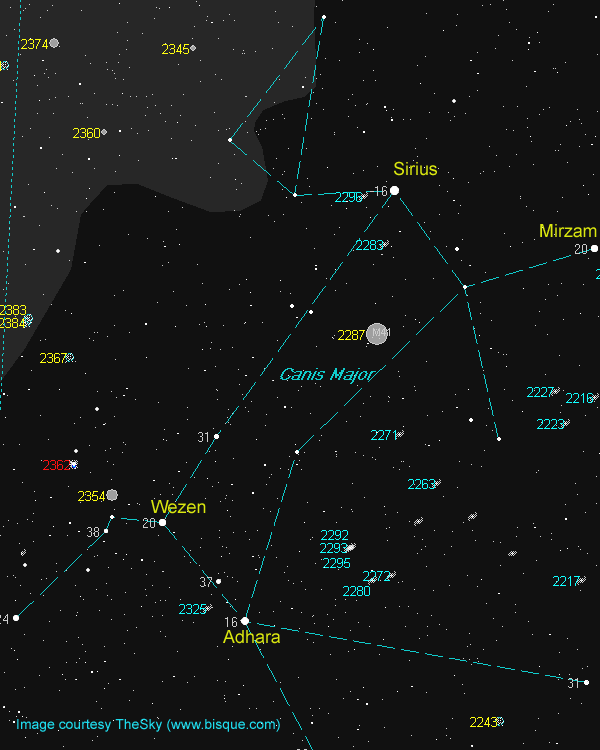Orion’s K-9’s
As we finally leave winter behind this month and jump into spring, we cannot help but notice the days getting longer. As we tick our way through the calendar, our sun’s angle moves a bit farther north, rewarding us with more than three minutes of light per day. However, for astronomers, this translates into shorter and shorter nights. It is not until the month of June that we only begin observing at about 9:30 p.m. and later local time but for now, our observing window is still on our side.

Soon after our daytime star reseeds behind the western horizon, the brilliant planet Venus breaks the dusk sky for all to see and admire. This month follows Venus as it pulls away from Mars at its lower right. It then visits the planet Uranus on March 4 when both will be seen in a wide-angle eyepiece. A week later the red planet Mars swings by Uranus with the same separation. These are great opportunities to photograph two planets with roughly the same separation from each other. And let's not forget the thin crescent moon south of Mars on the 21st and then below Venus on the 22nd.
Once you have moved on from the planetary show, we notice the constellation Orion listing to its right as it sets at midnight by mid-month. We still have a while to check out the famous hunter’s dogs, namely Canis Major and Canis Minor. Both constellations have a bright star to its credit. In the case of Canis Major to the lower left of Orion, it has the brightest star seen from Canada – Sirius. A mere 8.6 light-years from us, Sirius measures 1.75 times the radius of our Sun. In a small telescope, its blinding magnitude -1.5 starlight makes it a challenge to catch a glimpse of the companion (Sirius B) at magnitude +8.44. Companion B is a tiny star, a bit smaller than Earth and although it is 10,000 times fainter than its primary, this blue-white star registers a temperature of almost 24,800 Kelvin compared to Sirius at 9,880 Kelvin.

Before leaving Sirius, move your scope south by four degrees till you find the open cluster M41. About a third the way down to M41 you will also come across a 32 million light-year face-on barred spiral galaxy catalogued as NGC 2283 and has a magnitude of 12.2. With a couple of dozen bright stars combined with many fainter ones, M41 can be seen with the naked eye or in a low power eyepiece. It lies some 2,300 light-years from us and is about 26 light-years in width. There are many galaxies within the boundaries of Canis Major but are of the 13th and 14th magnitude range.
As you move your scope north from Sirius to brilliant Procyon, about one-third the way up you will come across the beautiful Seagull Nebula. Catalogue number IC 2177 is an emission nebula located some 3,650 light-years from us. The Seagull’s head is awarded catalogue number NGC 2327 and is a combination HII region and reflection nebula.

Continue up bright Procyon. This sun is only 11.4 light-years from us and shines around magnitude zero. And unlike Sirius, Procyon also has a fainter companion at magnitude 10.8. Procyon is a spectral class F5 star and is hotter than our Sun which has a spectral class of G2. Canis Minor is also home to faint galaxies, many of which are round and a challenge in small telescopes.
Comet Lovejoy is zipping up way back into interstellar space. It will not return to our solar system for another 8,000 years. Even though Lovejoy is no longer a showpiece in the sky and the talk of the town, it is still well placed for last chance viewing as it came closest to the Andromeda Galaxy on Valentine’s Day. Who knows when the next bright naked-eye comet visit?
As mentioned at the beginning of this article, our observing time is slowly shortening down to the first day of summer – the longest day. As most of us adjusted our clocks in November, it is now time to reverse that setting. Remember to move the clocks ahead by one hour at 2 a.m. on Sunday, March 8 as we move to Daylight Saving Time. Also, keep in mind to adjust your conversion to Universal Time. The 8th is also the time to look for the Zodiacal Lights in the west over the next two week period. Dark country skies are required to see and image them. This wedge of light rides the ecliptic and is the leftover interstellar dust from the creation of the solar system. The ray of dust particles can reach the Pleiades star cluster.
The Full Worm Moon occurs on March 5 at 18:05 UT and due to its distance from Earth will be the smallest of 2015. Some fifteen days later is a busy one as we have the New Moon at 9:36 UT and also plays a part in the first total solar eclipse of the year. It does, however, occurs in the south and east of Iceland. This is also when the Vernal Equinox (spring) occurs at 22:45 UT.
Until next month, clear skies everyone.
Twitter: @astroeducator
